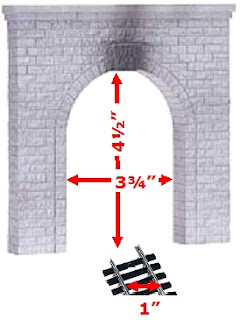Everything on model trains, model railroads, model railways, locomotives, model train layouts, scenery, wiring, DCC and more. Enjoy the world's best hobby... model railroading!
Avoiding Problems In Tunnels
 The fascination with tunnels is when the train disappears into the darkness and then, all going well, mysteriously reappear on the other side of the mountain. However, what happens if the train stops or derails inside the tunnel? It can be extremely frustrating if you know exactly where the train is, but are unable get it to it without doing some damage.
The fascination with tunnels is when the train disappears into the darkness and then, all going well, mysteriously reappear on the other side of the mountain. However, what happens if the train stops or derails inside the tunnel? It can be extremely frustrating if you know exactly where the train is, but are unable get it to it without doing some damage.
The simple solution is to always have a method of accessing or removing your trains from tunnels. Some model train hobbyists build a secret removable panel into the side of the mountain for easy access.
Another important thing when building tunnels is to carefully calculate clearances when building tunnels.
Always check there is enough space for your biggest locomotive to run through the entire stretch of tunnel especially if the track does not run straight line.
You wouldn’t want to apply paper mache to the chicken wire frame of the tunnel (if that is the construction method you use), only to discover your biggest loco is too high to get through the tunnel.
Tunnels can look unrealistic if the clearances are too low or too narrow. A tunnel also needs to accommodate the longest freight or passenger train you might ever want to run. The other thing to consider is that steam engines were taller than the model diesel locomotives.
So, if you ever want to run steam locomotives, then make sure there is enough clearance top and sides throughout the entire tunnel length (allowing for bends in the track).
My suggestion is to make tunnels higher. I see so many tunnels constructed for modern diesel locos which are not as high and much shorter than steam trains were. They don’t look real. When you see photos of real railroads, the tunnels are often quite old, and many were originally built to take steam engines which were higher. The tunnels had to accommodate the taller engines and the plume of smoke they belched out.
Look at photos and measure the proportions of the tunnel entrance in relation to the distance between the rails. You might find that some tunnels are 4½ times higher than the width of the rails. The width of the tunnel might be 3¾ times wider than the rail width. A narrow tunnel might cause derailments with longer cars.
If the engine is nearly 12 inches in length, has 8 axles, and is about 3 inches wide, then the tunnel should be long enough, high enough and wide enough to accommodate the engine as well as the other cars. This is especially true if you have parallel track flowing through the tunnel.
Building your own model railroad tunnels can be a lot of fun. You can buy ready-made tunnel portals (ends) to add a touch of realism. They look much more realistic at a tunnel entrance than a rough-cut hole. You can ‘weather’ them with gray-wash, chalk, etc. You can also purchase plastic kit-set tunnels in different scales. Finishing off the tunnel with matt paint and adding some ground cover can be very effective. Some model train shops and online retailers even sell tunnels that have bends, or can be extended, or joined together. The possibilities are endless.
To blacken the insides of tunnels use a flat black paint on all interior surfaces – walls, ceiling and floor. There’s nothing worse than a beautiful layout with a plywood-colored tunnel interior. Tunnels should be dark and mysterious.
More model train scenery and structures ideas
2 Responses to Avoiding Problems In Tunnels
Leave a Reply





















Another thing to give consideration too, is if you are likely to modernise your layout and want to run double stack container wagons, they need extra height clearance. I have just recently puchased a set of 5 Gunderson well deck wagons, but can only carry one container high, until I raise the height of all eleven tunnels. (mutter, mutter, mutter)
To add to the first post on avoiding height problems for double stacks cars (wagons) also, keep in mind the length of the newer (since early `70’s) the longer freight and passenger cars if the tunnel is on a curve (that is, if you can’t help placing the tunnel on the curve)Keep the curve on a tangent of 30″ or more. I made the mistake of making mine less than 30″ and eventually had to tear the whole thing plus over eight feet of track to accomidate the longer cars, the 6 axle monsters I use on the mine runs and several 60 foot freight cars and 75 foot passenger cars. It was one heckuva Ooops-Oh to correct. If you’re going to include tunnels do your best to plan for placing them in areas where the main or even a branch line is decently straight. ###